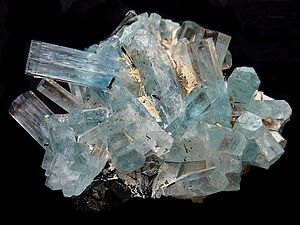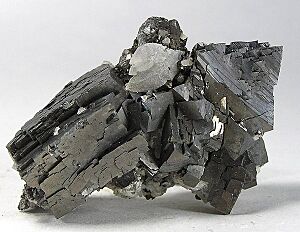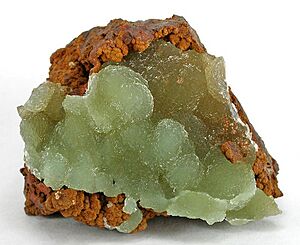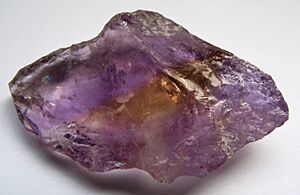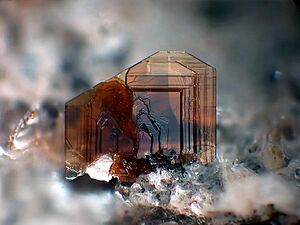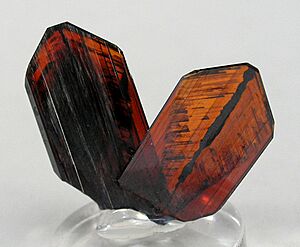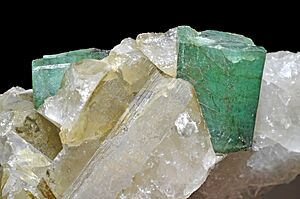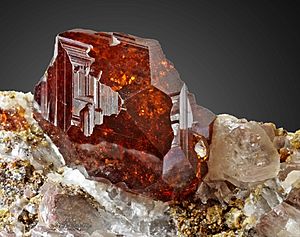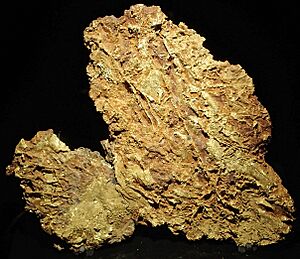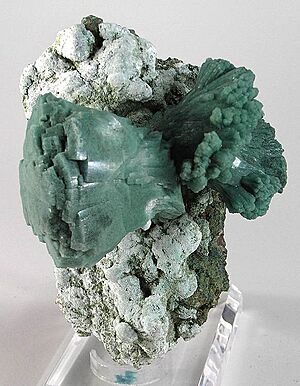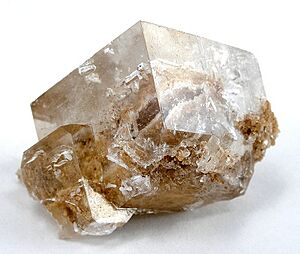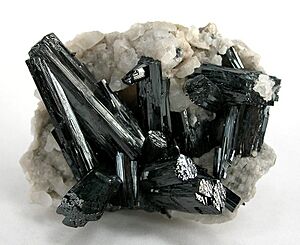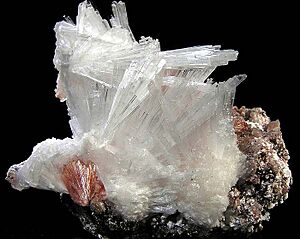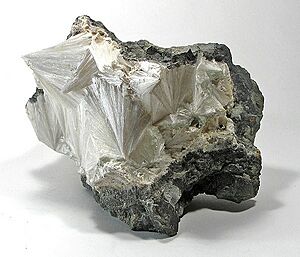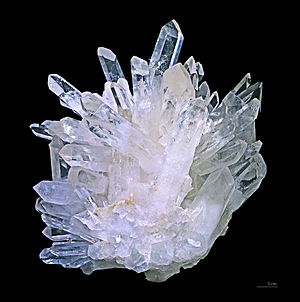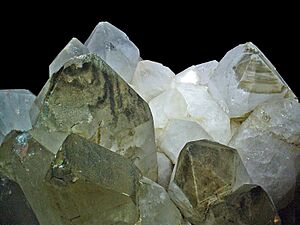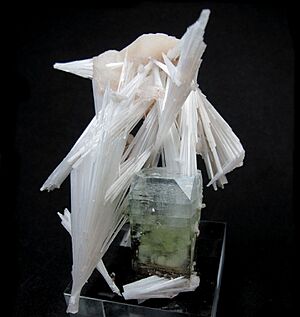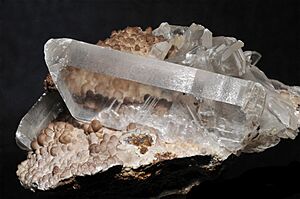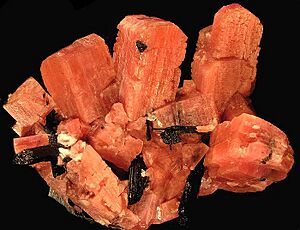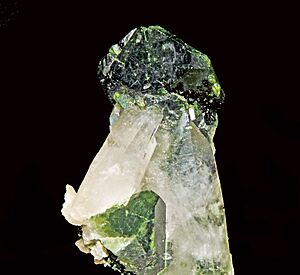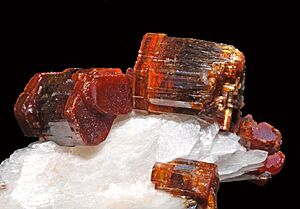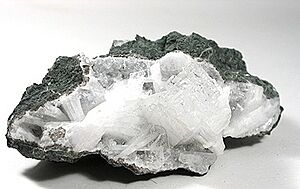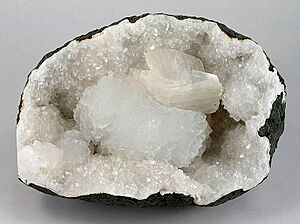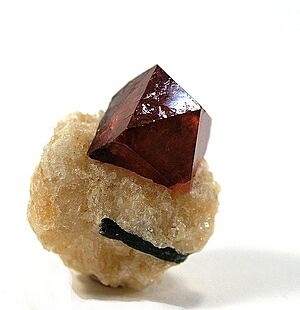List of minerals facts for kids
Minerals are amazing natural substances found all over the Earth! They are like the building blocks of rocks and soil. Each mineral is special because it has its own unique chemical makeup and a specific crystal structure. Think of it like a secret code that makes each mineral different from another.
Sometimes, within one type of mineral, there can be small differences in how it looks or tiny amounts of other stuff mixed in. When this happens, we call it a mineral variety. This list will show you some cool minerals that have their own Wikipedia pages.
For a super complete list of all known minerals, you can check out the List of minerals recognized by the International Mineralogical Association.
| Top - 0-9 A B C D E F G H I J K L M N O P Q R S T U V W X Y Z |
Awesome A Minerals
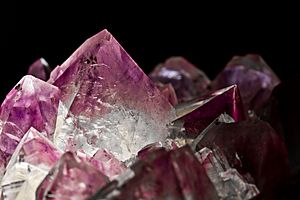

Minerals starting with 'A' include many interesting types. For example, Amethyst is a beautiful purple variety of quartz, often used in jewelry. Apophyllite crystals can form in cool shapes, sometimes next to other minerals like stilbite.
Aquamarine is a light blue variety of the mineral beryl. It often looks like clear ocean water. Arsenopyrite is a shiny, metallic mineral that contains iron and arsenic. Aurichalcite forms delicate, needle-like crystals. Austinite is another unique mineral, often found in specific mining areas.
Some other 'A' minerals you might hear about are:
- Actinolite
- Adamite
- Albite
- Almandine
- Aluminium
- Alunite
- Amblygonite
- Amphibole (a group of minerals)
- Analcime
- Andalusite
- Anglesite
- Anhydrite
- Ankerite
- Anorthite
- Antimony
- Apatite (a group of minerals)
- Aragonite
- Arsenic
- Astrophyllite
- Atacamite
- Augite
- Autunite
- Axinite (a group of minerals)
- Azurite
There are also many mineral varieties that start with 'A'. These are not separate minerals themselves, but special types of existing ones. For example:
- Agate (a variety of chalcedony and quartz)
- Alabaster (a variety of gypsum)
- Alexandrite (a variety of chrysoberyl)
- Amazonite (a variety of microcline)
- Aventurine (another variety of quartz)
Brilliant B Minerals

The 'B' section introduces us to minerals like Baryte, which can be found with other minerals like malachite. Benstonite often forms interesting coatings on other crystals. Biotite is a common mica mineral that forms thin, flaky layers. Brookite is a less common but beautiful titanium dioxide mineral.
Other important 'B' minerals include:
- Baddeleyite
- Bastnäsite (a mineral group)
- Benitoite
- Beryl
- Bismuth
- Borax
- Bornite
- Boulangerite
- Braunite
- Brazilianite
- Brewsterite (a series of zeolites)
- Brochantite
- Bromargyrite
- Brucite
- Brushite
Some 'B' varieties are:
- Bauxite (an aluminum ore, not a single mineral)
- Bentonite (a mixture of different clays)
- Bixbite (a red gem variety of beryl)
- Bowenite (a variety of antigorite)
Cool C Minerals

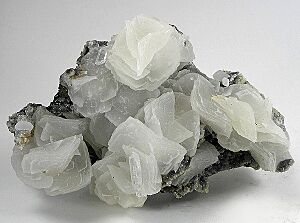
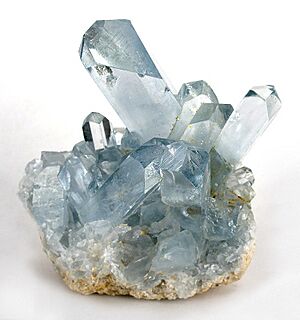
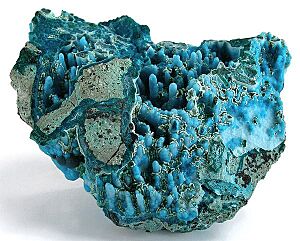

The 'C' section features some very common and important minerals. Calcite is found everywhere and can form in many different shapes, like the "wheatsheaf" or "petal" crystals shown. Celestine is known for its beautiful sky-blue crystals. Chrysocolla often forms in interesting stalactite shapes. Cinnabar is a bright red mineral that contains mercury.
Other notable 'C' minerals are:
- Cadmium
- Calaverite
- Cancrinite
- Carnallite
- Carnotite
- Cassiterite
- Cavansite
- Cerussite
- Chalcocite
- Chalcopyrite
- Charoite
- Chlorite (a mineral group)
- Chromite
- Chromium
- Chrysoberyl
- Chrysotile
- Cobaltite
- Copper
- Cordierite
- Corundum
- Covellite
- Creedite
- Cristobalite
- Crocoite
- Cryolite
- Cuprite
- Cylindrite
Some 'C' varieties include:
- Carnelian (a variety of quartz)
- Chalcedony (a microcrystalline variety of quartz)
- Chiastolite (a variety of andalusite)
- Chrysoprase (a green chalcedony)
- Citrine (a yellow variety of quartz)
- Crocidolite (a fibrous variety of riebeckite)
Dazzling D Minerals
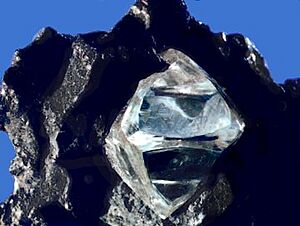
When we think of 'D' minerals, Diamond often comes to mind! Diamonds are famous for being the hardest natural material on Earth. They can be found in various shapes, like the octahedral crystal shown.
Other interesting 'D' minerals are:
- Danalite
- Danburite
- Datolite
- Diaboleite
- Diamond
- Diaspore
- Diopside
- Dioptase
- Dolomite
- Dumortierite
- Dundasite
- Dyscrasite
Some 'D' varieties are:
- Diallage (a mix of augite and diopside)
Exciting E Minerals
For 'E' minerals, Emerald is a standout! Emerald is a beautiful green gem variety of beryl, often found in quartz. It's one of the most famous gemstones.
Other 'E' minerals you might encounter are:
- Edenite
- Edingtonite
- Ekanite
- Elbaite (a type of colorful tourmaline)
- Enargite
- Enstatite
- Epidote
- Epsomite
- Erythrite
- Euclase
- Eudialyte (a mineral group)
Fantastic F Minerals
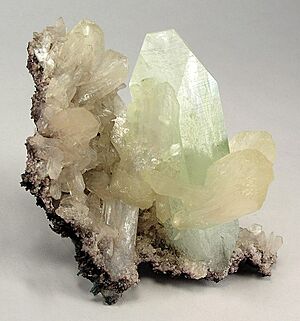
The 'F' section brings us to minerals like Fluorapophyllite, which can be found with stilbite. Fluorite is a very popular mineral among collectors because it comes in many vibrant colors and forms beautiful cubic or octahedral crystals.
Other important 'F' minerals include:
- Fayalite (part of the olivine group)
- Feldspar (a major mineral group)
- Ferberite
- Ferrierite (a zeolite mineral)
- Fluorapatite (part of the apatite group)
- Fluorite
- Forsterite (part of the olivine group)
- Franklinite (part of the spinel group)
A common 'F' variety is:
- Fluorspar (another name for fluorite)
Great G Minerals
In the 'G' section, we find Garnet, which is actually a group of minerals known for their beautiful colors, often red. Garnets are popular gemstones. And of course, there's Gold! Gold is a precious metal that can be found in veins within other rocks.
Other interesting 'G' minerals are:
- Gadolinite (a mineral group)
- Galena
- Garnet (a mineral group)
- Gaspeite
- Gibbsite
- Glauberite
- Glauconite
- Glaucophane
- Goethite
- Gold
- Graphite
- Greenockite
- Grossular
- Grunerite
- Gypsum
Some 'G' varieties include:
- Garnierite (a nickel ore)
- Goshenite (a colorless variety of beryl)
Helpful H Minerals

The 'H' section includes Hematite, an important iron ore that often forms shiny, trigonal crystals. Heulandite is a type of zeolite mineral, and Hübnerite is a tungsten mineral often found with quartz.
Other 'H' minerals are:
- Halite (rock salt)
- Halloysite
- Hanksite
- Harmotome
- Hausmannite
- Hauyne
- Hedenbergite
- Hemimorphite
- Herderite
- Hessite
- Hibonite
- Hornblende (a series of amphiboles)
- Howlite
- Humite
- Huntite
- Hydroxylapatite
- Hydrozincite
Some 'H' varieties include:
- Heliodor (a greenish-yellow variety of beryl)
- Heliotrope (a variety of chalcedony)
- Hessonite (a variety of grossular garnet)
- Hiddenite (a variety of spodumene)
- Hyalite (a variety of opal)
Interesting I Minerals
For 'I' minerals, Inyoite is a cool example, often found in specific geological locations. Ilmenite is another important mineral, a titanium-iron oxide.
Other 'I' minerals include:
A common 'I' variety is:
- Iolite (a gem-quality variety of cordierite)
Jewel J Minerals

The 'J' section features joaquinite-(Ce), which can be found alongside other unique minerals like benitoite and neptunite. Jadeite is also a very well-known mineral, famous for being one of the two minerals known as jade.
Other 'J' minerals are:
- Jacobsite
- Jadarite
- Jadeite
- Jamesonite
- Jarosite
- Jeremejevite
- Johannite
- Johannsenite
- Jordanite
- Julgoldite
Some 'J' varieties include:
Keen K Minerals
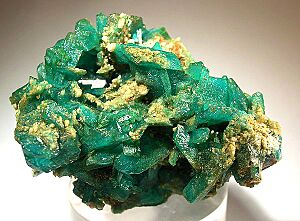
For 'K' minerals, we have Kainosite-(Y), found in places like the Black Forest. Kröhnkite is another interesting mineral, often found in copper mining districts.
Other 'K' minerals are:
- Kainite
- Kamacite
- Kaolinite
- Kermesite
- Kernite
- Kieserite
- Kleinite
- Kobellite
- Kornerupine
- Kyanite
A notable 'K' variety is:
- Kunzite (a variety of spodumene)
Lovely L Minerals

The 'L' section includes Langite, a copper sulfate mineral. Legrandite forms beautiful crystals, often on limonite. Liddicoatite is a colorful tourmaline mineral, often found with quartz and feldspar.
Other 'L' minerals are:
- Labradorite
- Langbeinite
- Lansfordite
- Laumontite
- Laurite
- Lawsonite
- Lazulite
- Lazurite
- Lead
- Lepidolite
- Leucite
- Linarite
- Linnaeite
- Livingstonite
- Lizardite
- Loellingite
- Lonsdaleite
- Ludlamite
- Ludwigite
Some 'L' varieties include:
- Larimar (a blue variety of pectolite)
- Lignite (a type of coal, not a mineral)
- Lodestone (a synonym for magnetite)
Magnificent M Minerals

The 'M' section has some very important minerals. Magnetite is a common iron ore and is naturally magnetic! Manganite is a manganese oxide mineral. Mesolite forms delicate needle-like crystals. Mimetite often forms interesting botryoidal (grape-like) shapes.
Other key 'M' minerals are:
- Magnesite
- Malachite
- Manganite
- Marcasite
- Margarite
- Melanterite
- Mellite
- Mica (a group of silicate minerals)
- Microcline
- Millerite
- Mimetite
- Moissanite
- Molybdenite
- Monazite
- Montmorillonite (a clay mineral)
- Mordenite
- Muscovite
Some 'M' varieties include:
- Meerschaum (a variety of sepiolite)
- Melanite (a variety of andradite garnet)
- Milky quartz (a cloudy white quartz)
- Morganite (a pink beryl)
Neat N Minerals
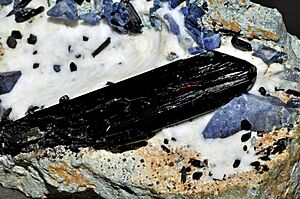
In the 'N' section, we find Natrolite, which often forms beautiful needle-like crystals. Neptunite is another striking mineral, known for its dark red crystals.
Other 'N' minerals are:
- Nagyágite
- Nahcolite
- Narsarsukite
- Natron
- Nepheline
- Nickel
- Nickeline
- Niter
- Nitratine
- Nontronite
- Norbergite
- Northupite
A common 'N' variety is:
- Nephrite (a variety of tremolite/actinolite, also known as jade)
Outstanding O Minerals
The 'O' section features Opal, a unique mineraloid (it lacks a true crystal structure) famous for its beautiful play of colors. Boulder opal, as shown, is opal found within ironstone.
Other 'O' minerals include:
- Okenite
- Oldhamite
- Olivenite
- Olivine (a group of silicate minerals)
- Omphacite
- Orpiment
- Orthoclase
- Osmium
- Osumilite
Some 'O' varieties are:
- Oligoclase (a mixture of albite and anorthite)
- Onyx (a banded variety of chalcedony)
Precious P Minerals

The 'P' section has many interesting minerals. Paravauxite forms beautiful crystals often with other minerals. Pectolite is known for its fibrous appearance. Phosphophyllite is a rare and highly prized mineral for its striking blue-green color. Pyrrhotite is a magnetic iron sulfide mineral.
Other important 'P' minerals are:
- Painite
- Palladium
- Palygorskite
- Pargasite
- Pearceite
- Pentlandite
- Periclase
- Perovskite
- Petalite
- Phenakite
- Phillipsite (a series of zeolites)
- Phlogopite
- Phosphosiderite
- Plagioclase (a feldspar series)
- Platinum
- Pollucite
- Polybasite
- Prehnite
- Proustite
- Pseudomalachite
- Pumpellyite (a group of minerals)
- Purpurite
- Pyrite (often called "fool's gold")
- Pyrochlore (a mineral group)
- Pyrolusite
- Pyromorphite
- Pyrope
- Pyrophyllite
- Pyroxene (a group of silicate minerals)
Some 'P' varieties include:
- Peridot (gem-quality olivine)
- Perlite (a type of volcanic glass)
- Phengite (a variety of muscovite)
- Pitchblende (a massive, impure form of uraninite)
Quirky Q Minerals
The 'Q' section is dominated by Quartz, one of the most common minerals on Earth. Quartz comes in many forms and colors, and is found in almost every type of rock.
Other 'Q' minerals are:
- Qingsongite
- Quenstedtite
- Quetzalcoatlite
Radiant R Minerals
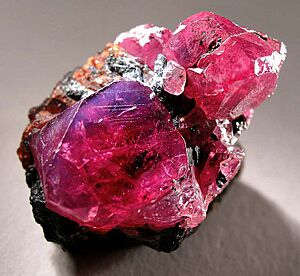
The 'R' section features Ruby, a stunning red gem variety of corundum, highly valued as a gemstone. Rock crystal is a clear variety of quartz.
Other 'R' minerals include:
- Realgar
- Rheniite
- Rhodium
- Rhodochrosite
- Rhodonite
- Richterite
- Riebeckite
- Ringwoodite
- Rosasite
- Roscoelite
- Ruby
- Rutile
Some 'R' varieties are:
- Rhodolite (a variety of pyrope garnet)
- Rose quartz (a pink variety of quartz)
Shining S Minerals
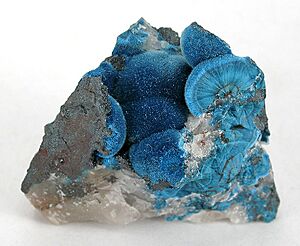
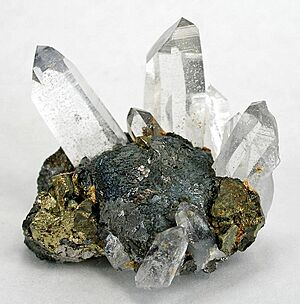
The 'S' section is full of diverse minerals. Scolecite forms delicate, needle-like crystals. Selenite is a clear, often beautiful variety of gypsum. Sérandite forms interesting clusters. Shattuckite often appears as blue, rounded masses. Stannite is a metallic mineral found with quartz and chalcopyrite.
Other important 'S' minerals are:
- Sal ammoniac
- Sanidine (an orthoclase variety)
- Saponite (a clay mineral)
- Sapphirine
- Scapolite (a group of silicate minerals)
- Scheelite
- Schorl (black tourmaline)
- Selenium
- Semseyite
- Sepiolite
- Serpentine group
- Siderite
- Silver
- Smithsonite
- Sodalite
- Sperrylite
- Spessartine
- Sphalerite
- Spinel
- Spodumene
- Staurolite
- Stephanite
- Stibnite
- Stichtite
- Stilbite (a series of zeolites)
- Strontianite
- Sulfur
- Sugilite
- Sylvanite
- Sylvite
Some 'S' varieties include:
- Sapphire (gem corundum of any color except red, especially blue)
- Sard (a variety of chalcedony/quartz)
- Satinspar (a variety of gypsum)
- Smoky quartz (a brown or black variety of quartz)
- Spectrolite (a variety of labradorite)
- Sunstone (a variety of oligoclase or orthoclase)
Terrific T Minerals
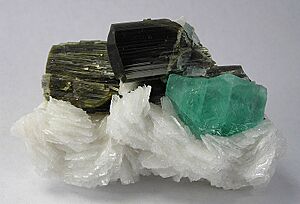
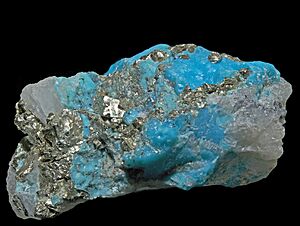
The 'T' section features minerals like Titanite, often found with other minerals. Tourmaline is a popular mineral group known for its wide range of colors and crystal shapes. Turquoise is a beautiful blue-green mineral, often used in jewelry.
Other important 'T' minerals are:
- Talc
- Tantalite
- Tellurium
- Tennantite
- Tetrahedrite
- Thaumasite
- Thenardite
- Thomsonite (a series of zeolites)
- Thorianite
- Thorite
- Tin
- Topaz
- Torbernite
- Tremolite
- Tridymite
- Trona
- Tungsten
Some 'T' varieties include:
- Tanzanite (a variety of zoisite)
- Thulite (a variety of zoisite)
- Travertine (a form of calcium carbonate, not a mineral)
- Tsavorite (a gem variety of grossular garnet)
Unique U Minerals
The 'U' section includes Uvite, a variety of tourmaline, often found with quartz. Uraninite is an important uranium mineral.
Other 'U' minerals are:
- Ulexite
- Ullmannite
- Uranophane
- Urea
- Uvarovite
Vivid V Minerals
The 'V' section features Vanadinite, known for its bright red to orange-red crystals.
Other 'V' minerals include:
- Vaesite
- Valentinite
- Vanadium
- Variscite
- Vaterite
- Vauxite
- Vermiculite
- Vesuvianite
- Villiaumite
- Vivianite
- Vulcanite
Wonderful W Minerals
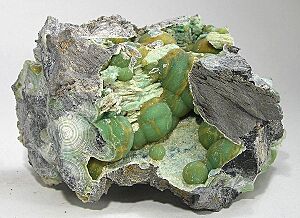
The 'W' section includes Wavellite, which often forms beautiful green, rounded masses.
Other 'W' minerals are:
- Wagnerite
- Wairakite
- Water (as solid, meaning ice)
- Weloganite
- Willemite
- Witherite
- Wolframite
- Wollastonite
- Wulfenite
- Wurtzite
Xtraordinary X Minerals
The 'X' section features Xonotlite, often found with other fibrous minerals like inesite.
Other 'X' minerals include:
- Xanthoconite
- Xenotime
Yellow Y Minerals
The 'Y' section includes Yugawaralite, which forms delicate crystals in sheltered pockets.
Other 'Y' minerals are:
- Yttrialite
Zesty Z Minerals
The 'Z' section features Zeolites, which are a group of silicate minerals often found with other crystals like heulandite and quartz. Zircon is a very common and important mineral, often used as a gemstone.
Other 'Z' minerals include:
- Zaratite
- Zektzerite
- Zincite
- Zinkenite
- Zirconolite
- Zoisite
- Zunyite
See also
 In Spanish: Anexo:Minerales para niños
In Spanish: Anexo:Minerales para niños
- Chemical gardening
-
- Classification of non-silicate minerals
- Classification of silicate minerals
- Classification of organic minerals
- Industrial mineral
- Critical mineral raw materials
- List of decorative stones
- List of individual gemstones
- List of minerals named after people
- List of minerals recognized by the International Mineralogical Association
- List of mineral tests
- Mineral collecting
- Timeline of the discovery and classification of minerals



